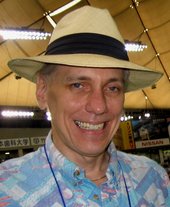
THE HOT CORNER: Kiyohara swaggers to the end

THE HOT CORNER: Kiyohara swaggers to the end
by Jim Allen (Oct 16, 2008)
Like him or not, Kazuhiro Kiyohara was an icon. He went from a schoolboy hero whose legend was larger than life, to a young pro whose promise was larger than life, to a caricature of a player whose body was larger than life.
If it is hard to reconcile the slim Seibu Lions first baseman with the bulky showman who finished his career as a sideshow, it is equally difficult to pin down the reason for his popularity.
In 1986, Kiyohara hit .304 as an 18-year-old rookie with 31 homers and 78 RBIs in 126 games. He was an obvious choice for Pacific League rookie of the year. As a sophomore, Kiyohara boosted his walks from 49 to 80, but that was about all the growth he had in him.
He set his career high in home runs at the age of 23, when he hit 37 and drew a career-best 105 walks with a .307 average--his best over a full season. Playing in the Yomiuri Giants' homer dome in 2001, Kiyohara reached a career-high of 121 RBIs--six behind Central League leader Roberto Petagine of the Yakult Swallows.
People repeatedly suggest that his failure to win a home run or RBI title is the reason he went on a body-building jag after joining the Giants. After two seasons in the Central League, Kiyohara's body ballooned and he suddenly became injury prone.
Despite impressive career accomplishments--2,122 hits with 525 of them home runs--Kiyohara was more about emotion than winning. Although he developed hardly a wit from the time he entered the game, Kiyohara thrived on drama. Nobody was a better big-game player: Put him in the Japan Series and watch out. But in the day-in, day-out regular-season grind, he never became more than a good hitter who could beat you now and then.
Kiyohara's size and swing stood out in a game defined by tiny details. While he turned his training regimen into an offseason show of guts and determination, Kiyohara could fall asleep in the field.
A few years back, one of his Giants teammates threw behind the runner to first. While the runner was taken back, Kiyohara didn't know a throw was coming until it hit him in the back and rolled away. It was almost as if the game he so loudly and dramatically pledged his blood and sweat to was not worthy of his attention.
Indeed, when chasing his 2,000th hit, Kiyohara showed his irritation with players who preferred winning to his little the-atre. One night, Kiyohara abused Hanshin Tigers reliever Kyuji Fujikawa for getting a swinging third strike on a forkball.
With Kiyohara looking fastball all the way, Fujikawa helped his team win with a strikeout--infuriating the veteran, whose purpose was putting on a show. After the game, Kiyohara questioned whether Fujikawa had all his reproductive organs.
Japanese ball is predicated on winning through obsession with details and quality control. As such, it sometimes has all the charm of an assembly line.
If that is one end of the spectrum, Kiyohara represented the other. Although he embraced Japan's fondness for showy displays of off-field effort, Kiyohara was a contradiction on the field. In a game that can beat the aggression and creativity out of players until they are stooped and bent, Kiyohara never lost his swagger.
This probably accounts for his popularity. Whatever his limitations, Kiyohara was a big figure on a small stage: full of heart and emotion in a game paralyzed by fear of making mistakes.
Kiyohara possessed the physical gifts needed to be Japan's greatest home run hitter ever. But physical talent can only take one so far. All-time home run king Sadaharu Oh was not an imposing physical figure--"I couldn't even do one pullup," he likes to say--but Oh found extreme discipline. Kiyohara just lacked the mental tools needed to raise his game.
His exit was fitting. As he made his final tour of PL parks, Kiyohara would be called on to pinch-hit and bring the house down for just being there. One afternoon at Seibu Dome, he was in the on-deck circle taking bows before the opposing team had even taken the field. Kiyohara struck out to the fanatic cheers of the fans.
His tearful final exit was more of the same: a celebration of swagger that was more about the illusion of winning than the real thing.
To access the original work (if still available), please reference:
http://www.yomiuri.co.jp/dy/sports/20081016TDY20302.htm.
Back to the works of Jim Allen
This work is licensed under a Creative Commons License.
Some rights reserved.
